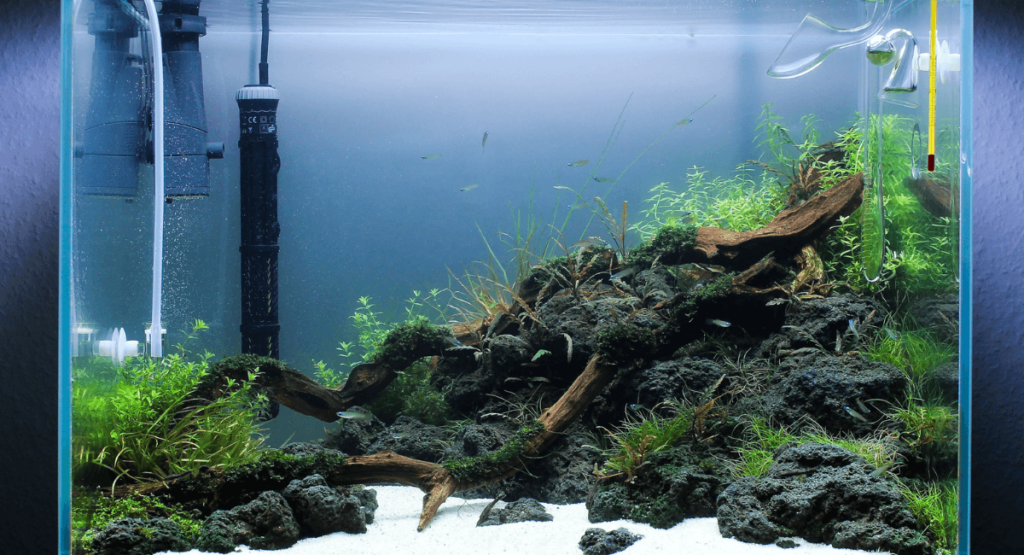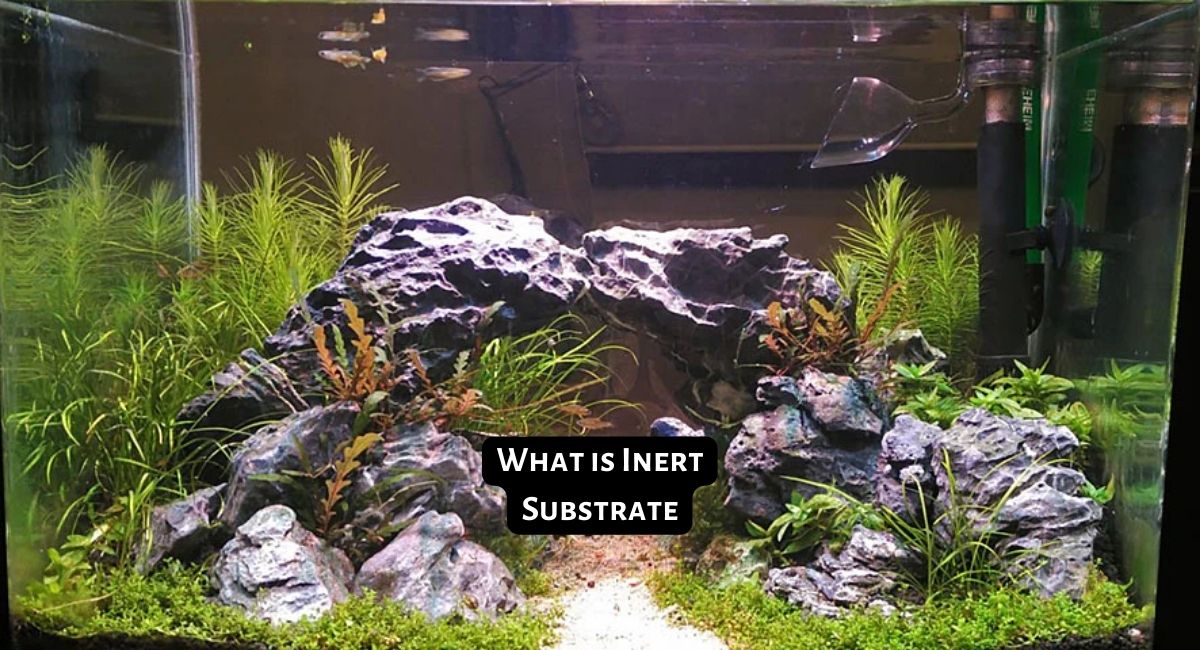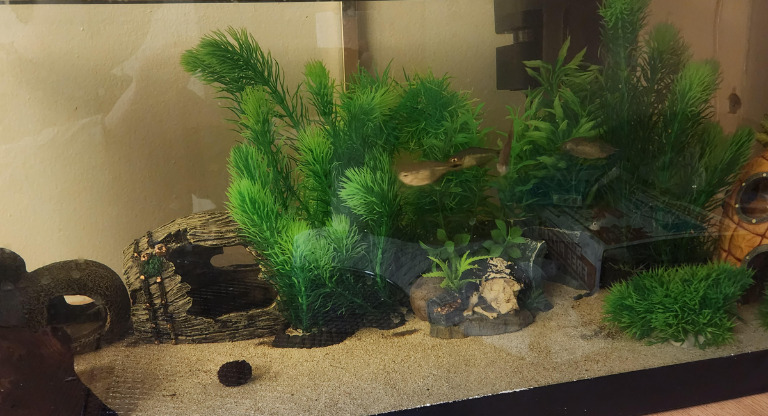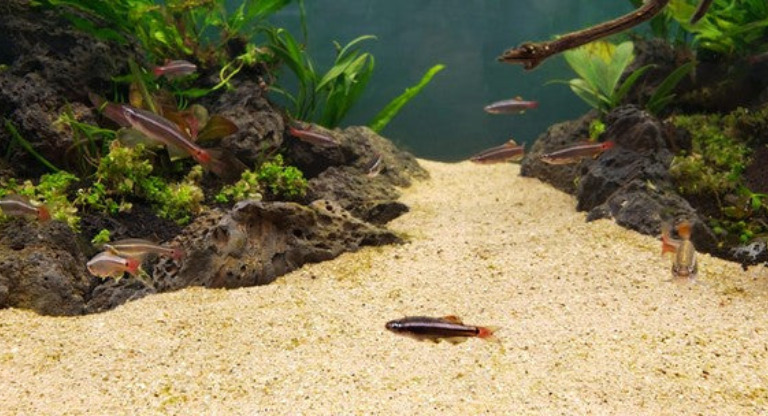Smartplantedaquarium.com participates in affiliate marketing programs. We may earn commissions on purchases made through our affiliate links. This doesn't affect our content or recommendations and we only recommend products we would put in our own tanks.
If you’re an aquarium enthusiast or considering setting up your own aquatic haven, understanding the role of substrates is crucial. Inert substrates play a significant role in creating a healthy and visually appealing environment for your aquatic inhabitants.
In this article, we will explore what inert substrates are, their benefits, and how to choose the right one for your aquarium.
Whether you’re a beginner or an experienced hobbyist, we hope this guide will provide valuable insights into the world of inert substrates and help you create a thriving aquatic ecosystem.
Contents
- Key Takeaways
- What is Inert Substrate
- Different Types of Inert Substrate
- How to Choose the Right Inert Substrate
- Advantages of Inert Substrate
- Disadvantages of Inert Substrates
- Inert Vs Active Substrate
- Soil Vs Inert Substrate
- How to Use Inert Substrate
- When Not to Use Inert Substrate
- Some Popular Brands of Inert Substrate
- Frequently Asked Questions
- Conclusion
Key Takeaways
- Inert substrate does not significantly alter water chemistry or aquarium parameters.
- It provides a neutral base for the aquarium and does not release substances that affect pH or hardness.
- Inert substrates are easy to clean and maintain.
- They provide a surface for beneficial bacteria to colonize and contribute to biological filtration.
- Common types of inert substrates include sand, gravel, quartz, granite, and glass beads.
- When choosing an inert substrate, consider compatibility with aquarium inhabitants, water parameters, aquascape design, ease of maintenance, and budget.
- Advantages of inert substrate include water chemistry stability, versatile aquascape options, beneficial bacteria colonization, and compatibility with aquatic life.
- Disadvantages of inert substrate include limited nutrient availability for plants, lack of buffering capacity, less natural appearance, limited cation exchange capacity, and reduced biological filtration potential.
- Inert substrate is different from active substrate, which actively participates in the nitrogen cycle and contains live beneficial bacteria.
- The choice between soil and inert substrate depends on the needs of the aquarium setup and the type of plants intended to grow. Soil substrate provides nutrients for plant growth, while inert substrate requires additional fertilizers and supplements.
What is Inert Substrate
An inert substrate refers to a type of substrate material that does not significantly alter the water chemistry or have an impact on the aquarium’s parameters. It is chemically stable and does not release any substances into the water that can affect the pH, hardness, or other aspects of water chemistry.
These substrates are often preferred in aquariums where specific water parameters need to be maintained or where the aquarium already has other means of controlling water chemistry, such as a dedicated filtration system. They provide a neutral base for the aquarium and allow the focus to be on other aspects, such as fish and plant care. Inert substrates are also relatively easy to clean and maintain.
It’s important to note that while inert substrates do not actively influence water chemistry, they can still provide a surface for beneficial bacteria to colonize, which contributes to the biological filtration process in the aquarium.
Different Types of Inert Substrate
Inert substrates are popular choices for aquarium enthusiasts due to their stability and minimal impact on water chemistry. They provide a neutral base for the aquarium environment while allowing the focus to be on other aspects of aquatic life.
Overall, inert substrates offer a versatile and low-maintenance option for aquarists looking for stability in their aquatic ecosystems. There are several types of inert substrates commonly used in aquariums. Here are some examples:
- Sand: Sand is a popular choice due to its fine texture and natural appearance. It comes in various colors, such as white, black, or brown, and is suitable for aquariums with bottom-dwelling fish or invertebrates. Sand allows for natural burrowing and foraging behaviors and is relatively easy to clean.
- Gravel: Gravel is another commonly used inert substrate. It comes in different sizes and colors, ranging from small pebbles to larger stones. Gravel offers versatility in aquascape designs and provides a stable surface for plants to root. It also allows for beneficial bacteria colonization and provides a natural aesthetic appeal to the aquarium.
- Quartz: Quartz is a type of rock that is often used as an inert substrate in aquariums. It is chemically stable and does not impact water chemistry. Quartz substrates can come in various colors, including white, gray, or various shades of brown. They provide a visually appealing base and can be used in different aquascape styles.
- Granite: Granite is another inert rock commonly used as a substrate. It is durable and does not break down over time. Granite substrates typically have a coarse texture and can add an interesting visual element to the aquarium. They are suitable for both freshwater and marine setups.
- Glass Beads: Glass beads are smooth, rounded, and inert substrate options. They provide a unique and modern look to the aquarium and are available in various colors. Glass beads are easy to clean and maintain and can be used to create striking visual effects.
How to Choose the Right Inert Substrate

Choosing the right inert substrate for your aquarium is essential to create a suitable and visually appealing environment for your aquatic life. When selecting the right inert substrate for your aquarium, there are several key factors to consider:
- Compatibility with Aquarium Inhabitants: Consider the specific needs of your aquarium inhabitants. Some fish or invertebrates may prefer a sandy substrate for burrowing or sifting through, while others may thrive better on a gravel or rocky surface. Research the natural habitat and behavior of your aquatic species to determine the most suitable substrate.
- Water Parameters: Take into account the water parameters you want to maintain in your aquarium. Inert substrates, by nature, do not significantly impact water chemistry. However, certain rocks or substrates may have a minor influence on pH levels or hardness. Ensure the chosen substrate aligns with your desired water parameters or consider alternative means of maintaining water chemistry.
- Aquascape Design: Consider the aesthetic you want to achieve. Different substrates offer various colors, textures, and sizes. Fine sand can provide a sleek and natural look, while gravel allows for creativity with colors and patterns. Rocks and stones add visual interest and can be used for creating caves or structure. Choose a substrate that complements your desired aquascape design.
- Ease of Maintenance: Evaluate the practicality of maintenance and cleaning. Some substrates may trap debris more easily or require more frequent vacuuming. Consider the effort required to keep the substrate clean and free of accumulated waste. Additionally, some substrates may affect plant growth. If you plan to have live plants, ensure the substrate allows for proper root development and nutrient circulation.
- Budget: Lastly, consider your budget. Inert substrates vary in price, with some options being more affordable than others. Determine your budget and choose a substrate that fits within your financial constraints while still meeting your requirements.
Advantages of Inert Substrate
Inert substrates in aquariums offer several benefits that make them a popular choice among aquarists. Here are some key advantages:
Water Chemistry Stability: Inert substrates have minimal impact on water chemistry. They do not alter pH levels or water hardness, allowing aquarists to maintain stable and consistent water parameters. This is particularly important for aquariums with sensitive or specialized aquatic species that require specific water conditions.
Versatile Aquascape Options: Inert substrates come in various types, sizes, and colors, offering a wide range of options for aquascape design. Aquarists can choose from sand, gravel, or rocks to create different textures, patterns, and visual effects in the aquarium. This versatility allows for creativity and customization, making the aquarium a visually appealing centerpiece.
Beneficial Bacteria Colonization: Inert substrates provide a surface for beneficial bacteria to colonize and establish a healthy biological filtration system. These bacteria help break down organic waste, converting harmful ammonia into less toxic substances like nitrate. The presence of an inert substrate promotes the growth and establishment of these beneficial bacteria, contributing to overall water quality and the well-being of aquarium inhabitants.
Ease of Maintenance: Inert substrates are generally easy to clean and maintain. They do not break down over time or release substances that cloud the water or require frequent replacement. Regular vacuuming or siphoning can remove debris or waste accumulated on the substrate surface, helping to maintain a clean and healthy environment for the aquarium inhabitants.
Compatibility with Aquatic Life: Inert substrates are suitable for a wide range of aquatic species, including both freshwater and marine environments. They provide a neutral and non-reactive substrate that accommodates the needs of various fish, plants, and invertebrates. Inert substrates allow fish to exhibit natural behaviors like burrowing or sifting through the substrate, promoting their well-being in the aquarium.
Disadvantages of Inert Substrates
While inert substrates offer many advantages, it’s important to consider some potential disadvantages as well. Here are a few factors to keep in mind:
Limited Nutrient Availability: Inert substrates do not provide a significant source of nutrients for plants. Unlike specialized planted tank substrates or nutrient-rich substrates like soil, inert substrates may require additional fertilization to support the growth of demanding aquatic plants. This means aquarists need to supplement the substrate with root tabs or liquid fertilizers to ensure adequate nutrient supply.
Lack of Buffering Capacity: Inert substrates do not possess buffering capacity, meaning they do not have the ability to stabilize pH levels in the aquarium. If you have fish or plants that require specific or stable pH conditions, you may need to use alternative methods such as chemical additives or specialized buffering substrates to maintain the desired pH range.
Less Natural Appearance: While inert substrates can still create an aesthetically pleasing aquascape, they may not provide the same natural appearance as substrates found in the natural habitats of aquatic species. Some aquarists prefer substrates that closely resemble the natural environment of their fish or plants, and inert substrates may not always achieve that level of authenticity.
Limited Cation Exchange Capacity: Inert substrates have limited cation exchange capacity, which means they have a reduced ability to absorb and release certain ions into the water. This can affect the availability of certain essential elements and minerals for plants and other aquatic organisms. It may require more frequent water testing and adjustment to ensure the necessary nutrient balance in the aquarium.
Less Biological Filtration Potential: While inert substrates do support the colonization of beneficial bacteria, they may have less surface area for bacterial growth compared to specialized porous substrates or live sand. This can result in slightly reduced biological filtration capacity, necessitating the use of other filtration methods such as external filters or biological media.
Inert Vs Active Substrate
When considering substrate options for your aquarium, you’ll come across two main categories: inert substrate and active substrate. Here are the key differences between the two:
| Criteria | Inert Substrate | Active Substrate |
|---|---|---|
| Definition | Substrate that does not affect water parameters or influence biological processes | Substrate that actively participates in the nitrogen cycle |
| Composition | Usually made of neutral materials like sand, gravel, or crushed coral | Contains live beneficial bacteria and organic matter |
| Water Parameters | Does not alter pH, hardness, or other water parameters | Can affect pH, hardness, and nutrient levels, depending on the type |
| Nitrogen Cycle | Does not contribute to the nitrogen cycle | Helps establish and maintain a healthy nitrogen cycle in the aquarium |
| Beneficial Bacteria | Does not contain beneficial bacteria | Contains live beneficial bacteria to aid in the breakdown of waste |
| Plant Growth | Requires the use of fertilizers and supplements for plant growth | Provides nutrients to support plant growth without additional additives |
| Maintenance | Minimal maintenance required | Requires occasional maintenance like vacuuming or siphoning to prevent anaerobic pockets |
| Cost | Generally less expensive | Can be more expensive due to the inclusion of live bacteria |
| Aesthetics | Offers a variety of colors and sizes for aesthetic purposes | May be limited in appearance options, usually in natural colors |
Choosing between inert and active substrates depends on your specific goals, the requirements of your aquatic life, and your willingness to manage nutrient levels and water chemistry. Inert substrates are often preferred for their stability and ease of use, while active substrates are popular among planted aquarium enthusiasts looking for optimal plant growth and a natural aesthetic.
Soil Vs Inert Substrate
The choice between soil and inert substrate depends on the specific needs of your aquarium setup and the type of plants you intend to grow. Here are some key differences between soil and inert substrate:
| Criteria | Soil Substrate | Inert Substrate |
|---|---|---|
| Composition | Made of natural soil or clay mixed with organic matter | Usually made of neutral materials like sand, gravel, or crushed coral |
| Nutrient Content | Rich in nutrients for plant growth | Does not provide significant nutrients for plants |
| Plant Growth | Provides essential nutrients for healthy plant growth | Requires the use of fertilizers and supplements for plant growth |
| Biological Activity | Supports the growth of beneficial bacteria and microorganisms | Does not actively participate in the nitrogen cycle |
| Water Parameters | Can affect pH, hardness, and nutrient levels | Does not alter pH, hardness, or other water parameters |
| Maintenance | May require regular monitoring and occasional maintenance like pruning or replanting | Minimal maintenance required |
| Cost | Generally more expensive | Generally less expensive |
| Aesthetics | Offers a natural and lush appearance | Offers a variety of colors and sizes for aesthetic purposes |
| Compatibility | May release tannins or affect water quality in some cases | Compatible with a wide range of fish and invertebrates |
Ultimately, the choice between soil and inert substrate depends on the specific requirements of your planted aquarium and the plants you intend to grow. If you have demanding or nutrient-sensitive plants, or if you want to minimize the need for additional fertilization, a soil substrate may be a better option.
On the other hand, if you prefer precise control over water parameters, flexibility in design, and easier maintenance, an inert substrate might be more suitable. Consider the needs of your plants, your desired aesthetic, and your willingness to manage nutrient levels and water chemistry when making the decision.
How to Use Inert Substrate
Using inert substrate in your aquarium is relatively straightforward. Here’s a step-by-step guide on how to use inert substrate:
- Prepare the Aquarium: Set up your aquarium by thoroughly cleaning it and ensuring all equipment, such as filters and heaters, are in place and functioning properly.
- Rinse the Substrate: Before adding the inert substrate to your aquarium, it’s important to rinse it thoroughly to remove any dust, debris, or loose particles. Place the substrate in a clean bucket or colander and rinse it under running water until the water runs clear. This helps prevent cloudiness in the aquarium.
- Add a Substrate Layer: Start by adding a layer of inert substrate to the bottom of your aquarium. The depth of the substrate layer depends on your preference and the needs of your aquarium inhabitants. Generally, a depth of 1-2 inches (2.5-5 cm) is suitable for most setups.
- Level the Substrate: Use your hand or a clean aquarium tool to distribute and level the substrate evenly across the aquarium bottom. Smooth out any uneven areas to create a uniform substrate layer.
- Decorate and Aquascape: Once the substrate is in place, you can add any desired decorations, such as rocks, driftwood, or plants. Arrange them according to your preferred aquascape design, considering the needs and preferences of your aquatic life.
- Fill the Aquarium with Water: Carefully fill the aquarium with water, taking care not to disturb the substrate or displace the decorations. It’s recommended to pour the water onto a plate or use a container to direct the flow, minimizing disturbance to the substrate.
- Cycle the Aquarium: If your aquarium is new, it will need to go through the nitrogen cycle to establish beneficial bacteria. Monitor water parameters, perform regular water testing, and consider using products to aid in the cycling process.
- Add Fish and Plants: Once the aquarium is fully cycled and stable, you can gradually introduce fish and plants to the tank. Follow proper acclimation procedures to minimize stress for the new inhabitants.
- Regular Maintenance: Maintain the aquarium by performing routine tasks such as water changes, cleaning the substrate surface with a siphon vacuum to remove debris and waste, and monitoring water parameters to ensure optimal conditions for your aquatic life.
When Not to Use Inert Substrate
While inert substrates have their advantages, there are certain situations or setups where they may not be the most suitable choice. Here are some instances when you might consider using alternative substrate options:
- Planted Tanks with Demanding Plants: If you plan to create a heavily planted tank with demanding aquatic plants that require nutrient-rich substrates, inert substrates may not provide adequate nutrient availability. In this case, using nutrient-rich substrates specifically designed for planted aquariums, such as soil-based substrates or specialized planted tank substrates, may be more beneficial.
- Species with Specific Substrate Requirements: Some fish species have specific substrate preferences that may not align well with inert substrates. For example, certain bottom-dwelling species, like sand-sifting or substrate-burrowing fish, may require fine sand or specific substrates to support their natural behaviors. Research the specific needs of your fish species and choose a substrate that accommodates those requirements.
- Aquascapes Emphasizing Natural Appearance: If your goal is to replicate a specific natural environment or biotope in your aquarium, using inert substrates may not provide the desired authenticity. In such cases, using substrates that closely resemble the natural habitats of your chosen fish or plants, such as specialized river sand or substrate mixes, can help create a more natural appearance.
- Tanks Requiring pH or Water Hardness Adjustments: Inert substrates do not possess buffering capacity, meaning they do not have the ability to stabilize pH levels or alter water hardness. If you need to maintain specific pH or hardness levels in your aquarium, using substrates designed for buffering, such as crushed coral or specialized buffering substrates, might be more suitable.
- Aquatic Systems Requiring High Cation Exchange Capacity: Inert substrates have limited cation exchange capacity, meaning they have a reduced ability to absorb and release certain ions into the water. If you have specific requirements for ion exchange or need to provide optimal conditions for certain sensitive or specialized aquatic organisms, using substrates with higher cation exchange capacity, such as specialized mineral substrates, may be more appropriate.
Some Popular Brands of Inert Substrate
There are several popular brands that offer inert substrates for aquarium use. Here are a few well-known brands known for their inert substrate options:
CaribSea: CaribSea is a renowned brand that offers a wide range of aquarium substrates, including inert options. They provide substrates like CaribSea Super Naturals, which are natural-looking sands in various colors, and CaribSea Peace River, a smooth gravel substrate suitable for a range of aquarium setups.
Seachem: Seachem is a trusted brand in the aquarium industry known for its high-quality products. They offer inert substrates like Seachem Flourite Sand and Seachem Flourite Black, which are porous clay-based sands suitable for planted tanks and provide a stable base for aquatic plants.
ADA Aqua Soil: ADA Aqua Soil is a popular brand among aquascapers and planted aquarium enthusiasts. Their ADA Aqua Soil Amazonia and ADA Aqua Soil Amazonia Light are specialized substrates designed to provide essential nutrients for plant growth. While they do contain nutrients, they can still be considered inert as they do not significantly alter water chemistry.
Fluval: Fluval offers a variety of substrates, including inert options like Fluval Plant and Shrimp Stratum. These substrates are designed to provide a stable base for plant growth and are suitable for planted tanks or shrimp aquariums.
Imagitarium: Imagitarium is a brand that offers a range of aquarium products, including inert substrates like Imagitarium Black Aquarium Sand and Imagitarium White Aquarium Sand. These sand substrates provide a sleek and natural look for aquariums.
Frequently Asked Questions
1. Does inert substrate affect water chemistry or pH levels?
No, inert substrate typically does not have a significant impact on water chemistry or pH levels.
2. Can plants grow successfully in inert substrate?
Yes, plants can grow successfully in inert substrate. While some plants may benefit from specific nutrient-rich substrates, many aquatic plants can obtain their nutrients from the water column or through regular fertilization. Inert substrates can provide a stable anchoring point for plant roots and allow for healthy growth, as long as other essential factors like lighting, carbon dioxide levels, and nutrient availability are properly maintained.
3. Do you need to fertilize plants differently when using inert substrate?
When using inert substrate, it is generally recommended to provide additional fertilization to ensure optimal plant growth. Inert substrates do not release nutrients into the water column, so the plants may not have access to all the essential elements they need. You can fertilize plants using liquid or root fertilizers specifically formulated for aquatic plants. These fertilizers typically contain macronutrients (such as nitrogen, phosphorus, and potassium) as well as micronutrients (like iron, manganese, and zinc) necessary for healthy plant development.
4. Can inert substrate be combined with other types of substrate in the same tank?
Yes, inert substrate can be combined with other types of substrate in the same tank. This is often done to create a layered substrate system that provides different benefits. For example, you can place a layer of nutrient-rich substrate (such as specialized plant substrate or soil) beneath the inert substrate. This allows plant roots to access additional nutrients while still benefiting from the stability and anchoring provided by the inert substrate layer. Just ensure that the layers are properly separated to prevent mixing and maintain water clarity.
Conclusion
Inert substrates are an essential component of any aquarium setup, providing stability, aesthetic appeal, and a conducive environment for aquatic life. By opting for inert substrates, you eliminate the risk of chemical leaching and pH fluctuations, ensuring the well-being of your fish, plants, and invertebrates.
With the right inert substrate, you can create a beautiful and thriving underwater world that brings joy and serenity to both you and your aquatic companions.






